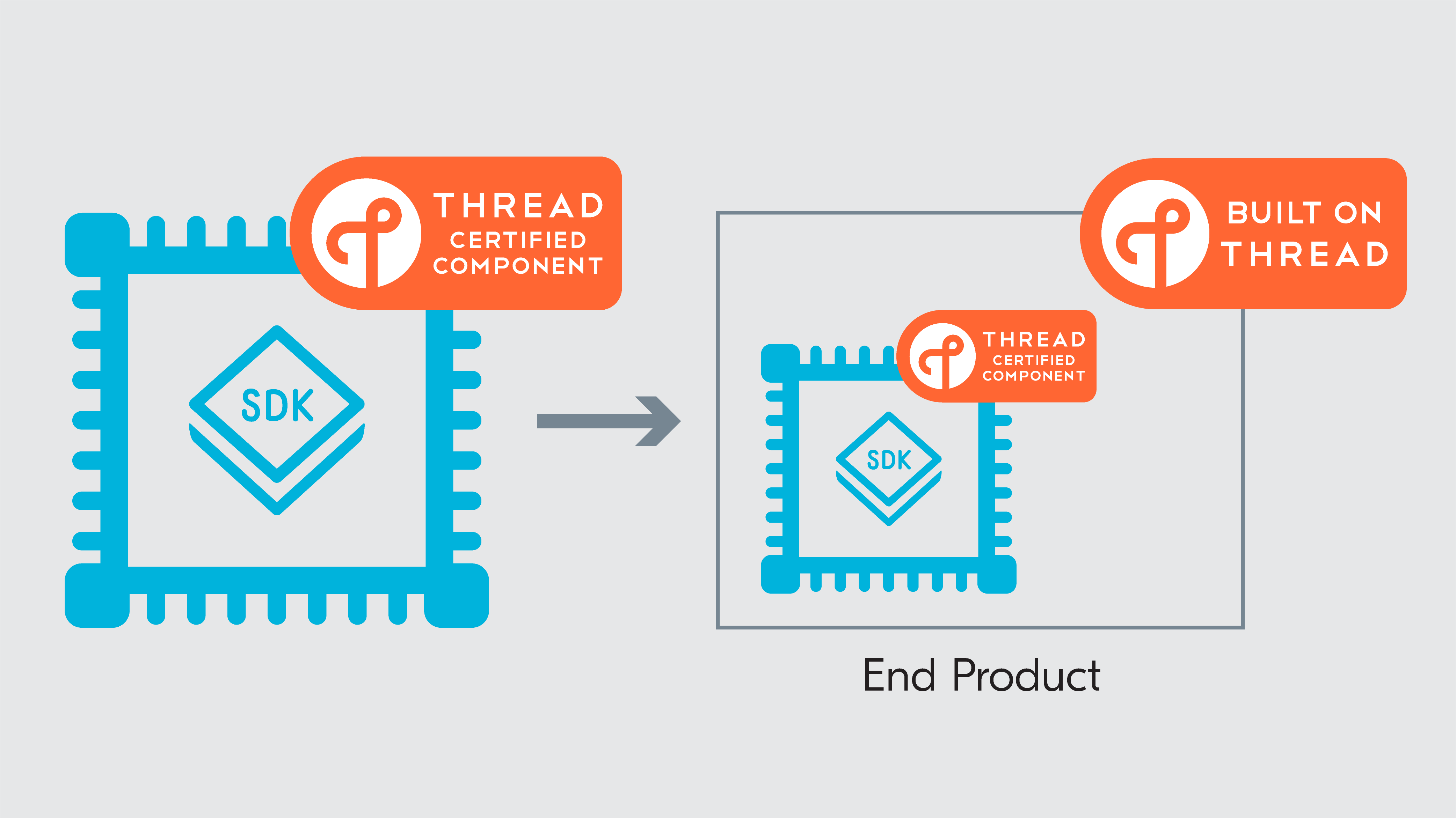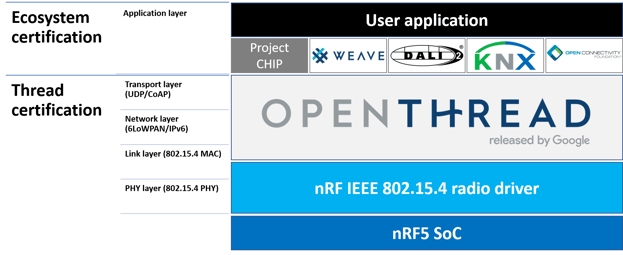Back to articles
Thread Certification by inheritance facilitates project CHIP

With Thread Group now supporting certification by inheritance, members of the Thread Group reduce dev costs by cutting time and money spent on certification processes and reuse certification already achieved on Nordic Thread products.
Until now, developing products with Thread technology and Nordic SoCs has initiated the need to certify the end product. Nordic customers have had to repeat a costly and time-consuming certification process even though the Nordic chip was certified by Thread.
With the new inheritance option, there are now two ways to achieve a Thread certification:
- Full certification at an Authorized Test Laboratory
- Inheritance from a previously certified component or end product.
Why Thread certification?
A Thread certification is a formal validation of the product’s conformance to the Thread specification and interoperability with leading Thread reference implementations.
A certification also implies rights to:
- Acquire a product license for intellectual property rights (IPR) to Thread technology
- Acquire a license to use the Thread Group certification logo with the product
- Promotion of the certified product via Thread Group PR and social media Listing of the certified product on the Thread Group website
Read more: An Introduction to Thread
Thread certification approaches for Nordic customers
Customers using our nRF52 and nRF53 Series SoCs have three options to achieve a Thread certification, two of which are by inheritance.
1. Straightforward Certification by inheritance
By using certified OpenThread stack binaries provided as part of nRF5 SDK for Thread and Zigbee, or nRF Connect SDK (planned for later in 2020), a customer demonstrates that the stack in the end product is indeed the same stack version that was certified. Thus, the certification process is plain paperwork.
However, Nordic does not maintain provided OpenThread stack binaries outside of SDK releases. If a customer needs any change to a provided binary (including a fix), they should follow "Certification by inheritance for a modified protocol stack" path below.
2. Certification by inheritance for a modified protocol stack
If a customer makes small modifications in the protocol stack source code (usually a different configuration) and generates binaries themselves but uses OpenThread GitHub commit certified together with a Nordic SoC, still can benefit from certification by inheritance.
However, one must demonstrate that the stack - as it operates in the end-product – does not exceed ’the operating parameters’ of the certified stack.
The process involves close conversation and collaboration with Thread’s Group Director of Certification.
3. Full certification in an Authorized Test Laboratory (ATL)
This approach is required if a product designer decides to
- use an OpenThread GitHub commit NOT certified for Nordic SoCs
- use an OpenThread GitHub commit certified for Nordic SoCs, but introduces changes which exceed the ‘operating parameters’ of the certified stack
A full certification process is needed, with the end product being tested by a Thread-certified ATL.
For every certified SoC, Nordic provides source code of OpenThread for full flexibility during development (options two and three) and three variants of binaries for option one to allow stress-free inheritance while ensuring optimal use of resources:
- Full image – supports all Thread roles and contains all OpenThread features
- FTD (Full Thread Device) – memory optimized variant for Router-type devices, contains all FTD mandatory features and selected optional features
- MTD (Minimal Thread Device) - memory optimized variant for (Sleepy) End Devices, contains all MTD mandatory features and selected optional features
What is Project Connected Home over IP (Project CHIP)
Amazon, Apple, Google, and the Zigbee Alliance joined together to develop and implement a new, unified, open-source application layer. Using Internet Protocol (IP) as basis, Project CHIP enables communication between cloud services smart home devices and mobile apps, and also aims to define a specific set of IP-based networking technologies for device certification.
Read more: Why We’re Excited For Connected Home Over IP
One of the goals for the first specification is to support Thread as an underlying technology. Nordic Semiconductor takes active role in Project CHIP development and plans to support the technology in Nordic SDKs.
Benefits of an inherited certification
With the introduction of Certification by Inheritance, Thread Group provides substantial benefits to developers using Nordic’s already Thread-certified SoCs to create new products in Project CHIP and other Thread based ecosystems.
The Thread protocol is application layer agnostic and does not define the application layer itself. To create a full-featured product, a designer usually puts an IP-enabled application layer on top of a Thread stack. Consequently, the application layer is defined by Project CHIP, Google’s Weave, Digital Addressable Lighting Interface (DALI), KNX, OCF etc.

By using Thread certification by inheritance, vendors now reduce their dev costs and time to market considerably. They can focus on an application layer certification rather than on certification for a middleware technology.
The costs are mainly related to engineering time and to hire a certified test lab. A vast amount of engineer time used on preparation for testing, as well as following the process either remotely or at the test site, is no longer needed. Also, avoiding costly test facility rates shaves thousands of dollars from the development costs.
An inherited certification process in its simplest version requires a minimum of work and thus cuts valuable time from the development process. Typically, an inherited certification process takes a couple of weeks, while a new certification may take from several weeks to as much as a few months.
Changes in membership
As the Thread Group has grown over the past four or five years, demands for another membership tier has emerged. Implementer is the newest tier designed for those looking to quickly and easily adopt Thread technology and bring Thread solutions to market at the lowest possible cost.
The Implementer tier is the first level with access to the certification process that enables them to stand on the shoulders of previously qualified Thread-certified components. Implementers can certify their solutions at their derived components or new products by inheritance.
By successfully certifying their products, they get the same benefits and access to intellectual property rights that are enjoyed by Contributor and Sponsor members today, as always with Thread, with no royalty payments.
For more details on the different Thread certification processes, we encourage you to refer to the Thread certification overview provided by Thread Group.
We also include a webinar from Thread Group where they explain the changes in membership tiers and explain different scenarios for components, modules, and end products opting for certification.

